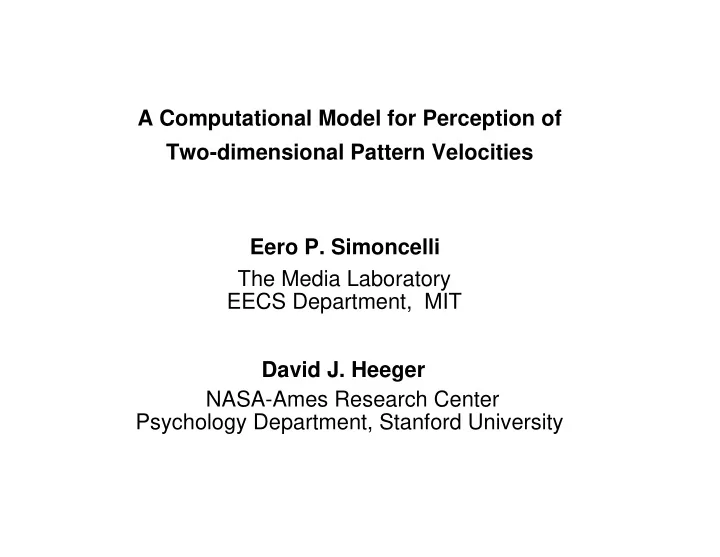

A Computational Model for Perception of Two-dimensional Pattern Velocities Eero P. Simoncelli The Media Laboratory EECS Department, MIT David J. Heeger NASA-Ames Research Center Psychology Department, Stanford University
Outline • Computational model: Bayesian velocity estimator • Simple two-stage model implementation • Model response to plaid stimuli • Comparison to psychophysical data: - Ferrera & Wilson, 1990, 1991 - Stone, Watson, Mulligan, 1990 Simoncelli & Heeger, ARVO-92
Bayesian Velocity Estimator • Gradient measurement equation, with noise model: I x (v - n 1 )+ I t + n 2 = 0 • Prior probability distribution on velocity: P(v) ~ N(0, σ v2 ) • Bayes' rule gives probability distribution on velocity: (I x v + I t ) 2 v 2 log P(v | I) ∝ ( σ e2 +I x2 ) σ v2 Simoncelli & Heeger, ARVO-92
Implementation: Stage 1 Input: image intensities . . . • Linear filtering, using spatio- temporally oriented operators . . . • Energy computation (squaring) σ e2 • • + • Divisive normalization, with semi- saturation parameter, σ e ÷ ÷ . . . • Outputs are spatio-temporally Output: normalized "energy" tuned Simoncelli & Heeger, ARVO-92 Simoncelli & Heeger, ARVO-92
Input: spatio-temporal energies Implementation: Stage 2 • • • • • • • σ v-2 • Weighted summation of stage 1 . . . energies over space, frequency + + bands Output: "velocity" • Some of the summations include prior variance parameter, σ v • Outputs are velocity tuned Simoncelli & Heeger, ARVO-92 Simoncelli & Heeger, ARVO-92
Grating Examples stimulus idealization model V y V y V x V x V y V y V x V x Simoncelli & Heeger, ARVO-92 Simoncelli & Heeger, ARVO-92
Plaids: Effect of Relative Contrast stimulus idealization model V y V y V x V x V y V y V x V x Simoncelli & Heeger, ARVO-92
Total Contrast Stone et al. 1990 5% 10% 20% 40% Subject Model 20 20 Perceived Direction Bias (degrees) 15 15 10 10 5 5 0 0 -5 -5 0 1 2 3 4 0 1 2 3 4 Log Contrast Ratio Log Contrast Ratio Simoncelli & Heeger, ARVO-92
Plaids: Effect of Grating Angles stimulus idealization model V y V y V x V x V y V y V x V x Simoncelli & Heeger, ARVO-92
Ferrera & Wilson, 1990 8 Perceived Direction Bias (degrees) 6 subject 4 model 2 0 Sym m etr i c I Asym m etr i c I Type I I Plaid Type Simoncelli & Heeger, ARVO-92
Ferrera & Wilson, 1991 1. 0 Perceived Speed (relative to IOC) 0. 8 subject2 model 0. 6 cosine 0. 4 0. 2 0 30 60 90 Plaid angle (degrees) Simoncelli & Heeger, ARVO-92
Summary of Model • Derived as a Bayesian estimator • Starting from image intensities, computes response of a population of velocity-tuned units • Implemented in two simple stages of computation • Velocity estimates are consistent with psychophysics of plaid perception Simoncelli & Heeger, ARVO-92
Simoncelli & Heeger, ARVO-92
Example Receptive Field y t x x Simoncelli & Heeger, ARVO-92
Spatio-temporal Filter Bank ω t ω x y t x x Simoncelli & Heeger, ARVO-92
Recommend
More recommend